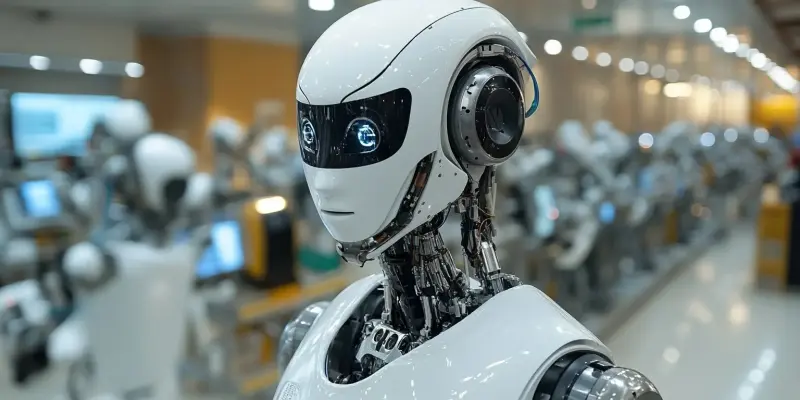The manufacturing sector has reached a pivotal moment where the integration of humanoid robots is steadily redefining operational paradigms.These advanced machines stand out for their ability to mimic human movements, making them well-suited for tasks traditionally performed by human workers. As these robots are becoming an increasingly common sight on production lines, they bring a host of advantages, including heightened efficiency and flexibility across various manufacturing processes.Humanoid robots are not merely replacing humans; they are enhancing the overall performance of production lines. Through advanced artificial intelligence (AI), these robots are capable of learning and performing complex tasks. They can be found assisting with the assembly of intricate components and managing logistics operations such as material transport within facilities.This new wave of automation is promising to revolutionize the way industries operate, with significant implications for productivity and operational efficiency.
Collaborative Efforts Driving Innovation
A noteworthy collaborative endeavor between Accenture, Schaeffler, Nvidia, and Microsoft underscores the potential of humanoid robots in manufacturing. This partnership aims to push the boundaries of industrial automation through the integration of physical AI, robotics, and cutting-edge simulation tools. These leading companies demonstrated their forward-thinking approach at Hannover Messe, showing how future factories might operate with seamless cooperation between humans, robots, and AI systems.Schaeffler’s Chief Operating Officer, Andreas Schick, highlighted the company’s commitment to utilizing innovations such as digital twins and humanoid robots to enhance operational excellence. According to Patrick Vollmer from Accenture, physical AI is transforming industrial automation by introducing novel methods to train and control different types of robots.This synergy enables manufacturers to achieve greater flexibility and productivity while addressing workforce shortages and challenges.
Specific humanoid robots, like Agility Robotics’ Digit and Sanctuary AI’s Phoenix, have been strategically deployed by Schaeffler. These robots are employed for material transport tasks and the assembly of spare part kits, integrating smoothly into workflows designed by humans.The utilization of Nvidia Omniverse’s digital twin simulations allows Schaeffler to meticulously plan facility layouts and test robot fleets virtually. This approach significantly minimizes commissioning times and optimizes automation levels, providing a more streamlined transition from planning to implementation.
Humanoid Robots in Action
Recent studies by Accenture reveal that 43% of industrial leaders expect humanoid robots to become a standard feature on assembly lines. Their principal appeal lies in their adaptability and ease of deployment. In light of this, Accenture and Schaeffler leverage Nvidia’s Omniverse Blueprint, specifically the Mega model, to test robot fleets within digital twins of industrial environments. This blueprint offers hyper-realistic simulations, creating a digital counterpart of real-world scenarios.Nvidia Omniverse, central to this industrial transformation, offers highly detailed simulations of factories and warehouses. Physical AI empowers robots to acquire skills by observing human workers. For instance, robots such as Phoenix can learn to compile spare part kits by analyzing digital twin data, thus accelerating skill acquisition without causing disruptions to ongoing operations. Using the Mega blueprint, multi-robot fleets can be tested in these virtual environments, ensuring that any potential issues are addressed before physical deployment.The advantages of adopting humanoid robots extend beyond efficiency gains. For example, they help in reducing downtime during production by reacting swiftly to changing operational demands. However, one significant concern is the potential displacement of the workforce.Companies like Accenture advocate for strategies tailored to foster human-robot collaboration. This includes employing Generative AI (Gen AI) assistants to support staff in troubleshooting issues quickly, which aids in reducing downtime without leading to job losses.
Future of Human-Robot Collaboration
As humanoid robots become an integral part of the manufacturing landscape, the emphasis is shifting towards fostering synergy between humans and robots.This human-robot collaboration is essential for fully leveraging the potential of advanced automation technologies. For manufacturers, the challenge lies in incorporating robots in a manner that complements rather than replaces their human workforce.
Strategically, the use of Gen AI assistants offers an innovative solution to this challenge.These AI systems assist human workers in efficiently managing the complexities of modern manufacturing processes. By providing instant support and guidance, they help in minimizing operational disruptions and enhancing productivity. This approach ensures that the workforce remains valuable and engaged, even as robots take on more of the repetitive and physically demanding tasks.
Additionally, the integration of digital twins allows manufacturers to simulate and optimize various aspects of production before implementing changes in the real world.This capability not only accelerates the rollout of new processes but also reduces the risk of unforeseen issues disrupting operations. Digital twins, combined with advanced simulations and robotics, provide a comprehensive framework for continuous improvement and innovation in manufacturing.
Moving Forward
The manufacturing industry is undergoing a transformation as humanoid robots become an integral part of operations, fundamentally changing traditional workflows. These advanced robots are distinguished by their ability to imitate human movements, making them highly effective for tasks that were once exclusively handled by human labor. As their presence on production lines grows, so do the benefits they bring—most notably, increased efficiency and enhanced flexibility in various manufacturing processes.These robots are not just substitutes for human workers; they significantly improve the overall performance of production lines. Equipped with sophisticated artificial intelligence (AI), they can learn and execute complex tasks with precision.Humanoid robots are increasingly involved in assembling detailed components and managing logistics, such as transporting materials within facilities. This surge in automation stands to radically alter industrial operations, offering profound advancements in productivity and operational efficiency.The implications are vast, promising a future where the integration of AI-driven robotics continues to streamline and optimize manufacturing sectors.

